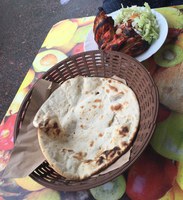Prairie Fare: Family Mealtimes Matter
(Click an image below to view a high-resolution image that can be downloaded)
By Julie Garden-Robinson, Food and Nutrition Specialist
NDSU Extension Service
“Mom was going to make tater tot hot dish,” my husband said with a grin.
I looked at him with narrowed eyes and raised eyebrows. I really exaggerated my expression for effect. He usually knows “the look” indicates he needs to stop talking.
Our three kids laughed at our interaction. Actually, I was teasing him, too, because I was enjoying our meal in an Indian restaurant more than I would a simple casserole.
Our kids are not so little any more. Our two older kids are in college and no longer living under our roof. We have decided to keep our family mealtime tradition whenever possible, though. Eating interesting meals together strengthens our family bond and helps us maintain our connection with our children as they enter adulthood.
We are collecting the dividends on a journey toward healthful eating. Through the years, our kids’ taste buds have become more adventuresome. In fact, nutrition research has shown that getting children to try new foods may take 10 or more times.
Our son used to eat his vegetables first just to be “done with it.” Our older daughter always was a good vegetable and ethnic food eater. Our younger daughter was the most neophobic (afraid of new things). At the Indian restaurant, she surprised me by ordering tandoori shrimp and chicken curry that evening.
As they feasted on garlic naan bread, I thought about our family’s adventures in eating. We never gave up on having our children try new foods. They helped in the kitchen, did many 4-H foods projects and visited interesting restaurants. At times, they chose American foods on the ethnic menus, but gradually their palates became used to trying something new. I often let them sample some of my entree.
Now they try to steal the last tandoori shrimp from my plate. I guess we need to review another lesson: Good Manners 101. I guarded my shrimp with a fork.
Eating together as a family has numerous benefits. In fact, regardless of your age, eating with others tends to promote eating a more balanced diet.
According to researchers, meals eaten with family members include less fat, less soda pop and more fruits and vegetables. Family meals also tend to be higher in calcium, fiber and other essential nutrients. Children who eat balanced meals with their families are less likely to become overweight.
When children get proper nutrition, their brains and bodies are fueled. They are better able to pay attention in school and learn. When they eat with their families, young children learn new words and expand their vocabularies. By the time they are teens, children who eat regularly with their families do better academically than their peers who do not.
Besides nutrition, regular family meals strengthen relationships and decrease stress. As a result of this family connection, teens are less likely to engage in risky behavior such as smoking, drinking alcohol or trying drugs.
“We haven’t made naan in a while,” our older daughter said as she reached for the last piece from the basket of bread.
“We need to do that soon,” I said.
Here’s a recipe we have made many times in the Robinson household. Our kids always have liked to take turns forming and cooking the bread on the griddle. I usually have to guard the bread so we have some remaining for dinner.
When making naan, add the flour gradually until you have a soft dough that isn’t too sticky to handle. We have made this bread with all-purpose flour as well as bread flour, and you may need to add a little more flour when using all-purpose flour.
Garlic Naan
1 (0.25-ounce) package active dry yeast
1 c. warm water
1/4 c. white sugar
3 Tbsp. milk
1 egg, beaten
2 tsp. salt
4 1/2 c. bread flour (add gradually)
2 tsp. minced garlic (optional)
1/4 c. butter, melted
In a large bowl, dissolve yeast in warm water and let stand about 10 minutes or until frothy. Stir in sugar, milk, egg, salt and enough flour to make a soft dough. Knead for six to eight minutes on a lightly floured surface or until smooth. Place dough in a well-oiled bowl, cover with a damp cloth and set aside to rise. Let it rise one hour until the dough has doubled in volume. Punch down dough and knead in minced garlic if desired. Pinch off small handfuls of dough. Form into balls and place on a tray. Cover with a towel and allow to rise until doubled in size, about 30 minutes. During the second rising, preheat electric grill to medium-high to high heat. Roll or stretch one ball of dough into a thin circle. Lightly oil grill. Place dough on grill and cook for two to three minutes or until puffy and lightly browned. Brush uncooked side with butter and turn over. Brush cooked side with butter and cook until browned, another two to four minutes. Remove from grill and continue the process until all the naan has been prepared.
Makes about 20 large naan. Each serving has 120 calories, 3 grams (g) fat, 2 g protein, 11 g carbohydrate and 240 milligrams sodium.
(Julie Garden-Robinson, Ph.D., R.D., L.R.D., is a North Dakota State University Extension Service food and nutrition specialist and professor in the Department of Health, Nutrition and Exercise Sciences.)
NDSU Agriculture Communication - Sept. 15, 2016
| Source: | Julie Garden-Robinson, 701-231-7187, julie.garden-robinson@ndsu.edu |
|---|---|
| Editor: | Ellen Crawford, 701-231-5391, ellen.crawford@ndsu.edu |



